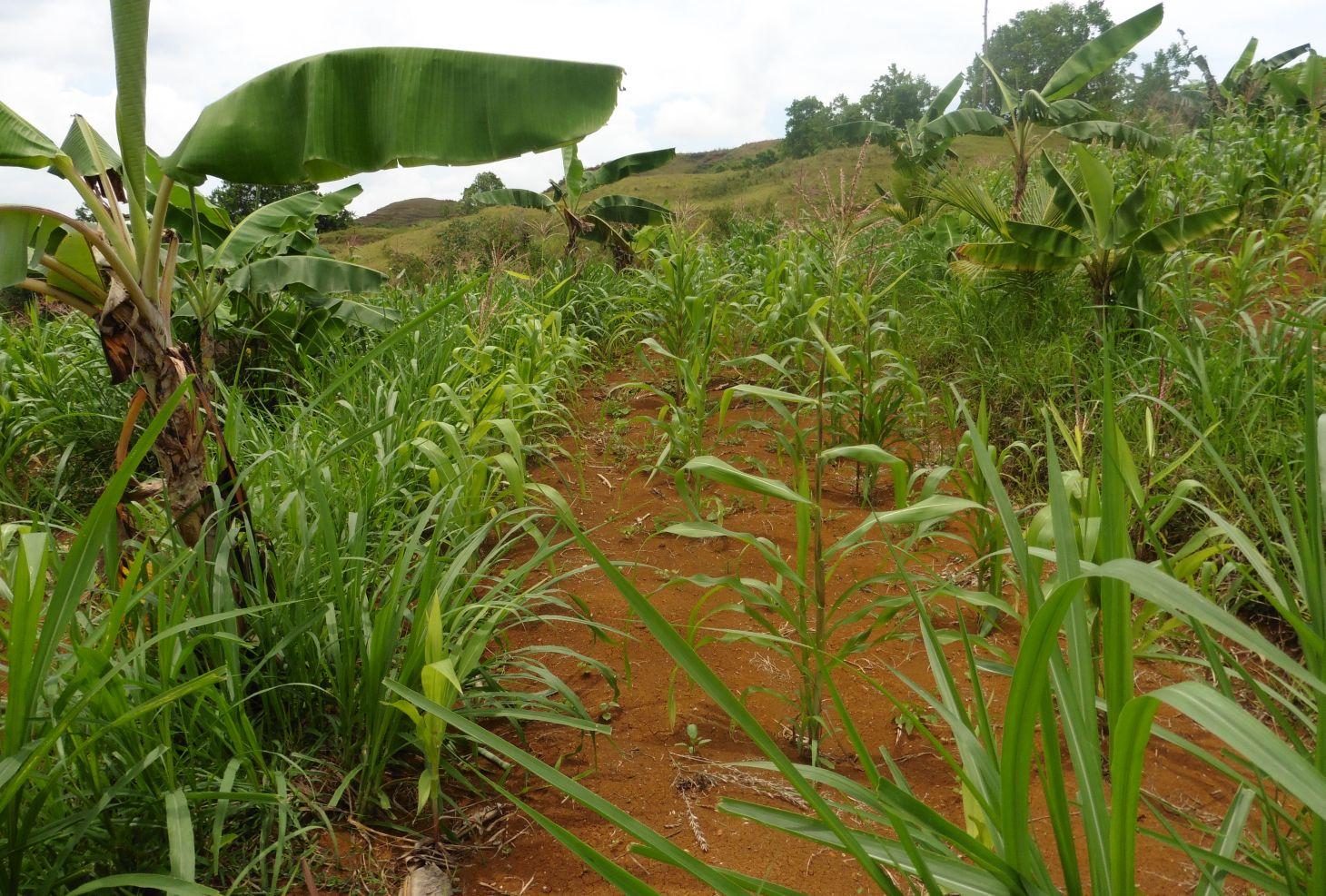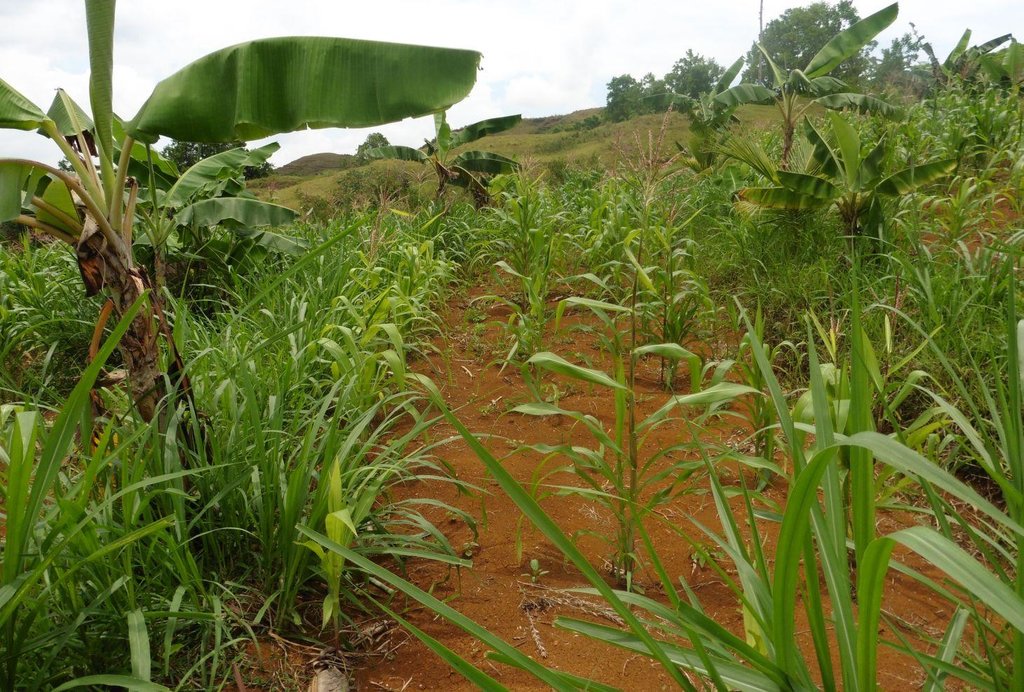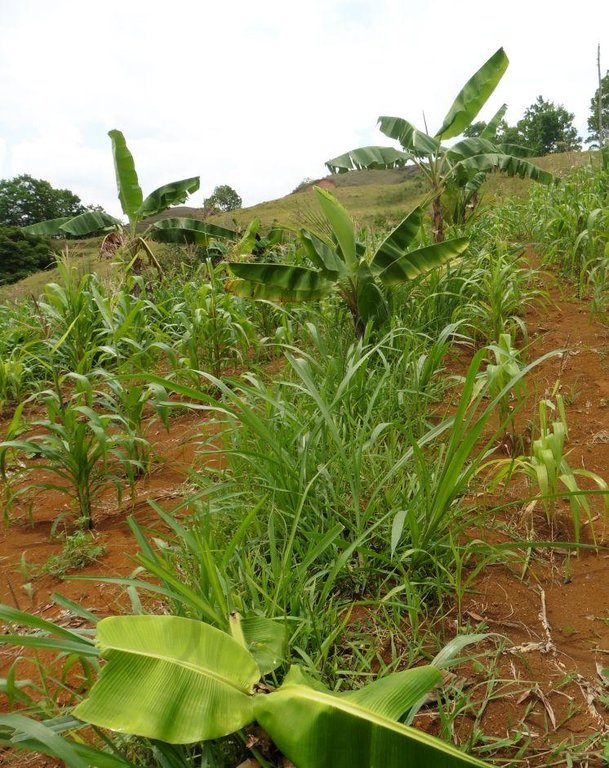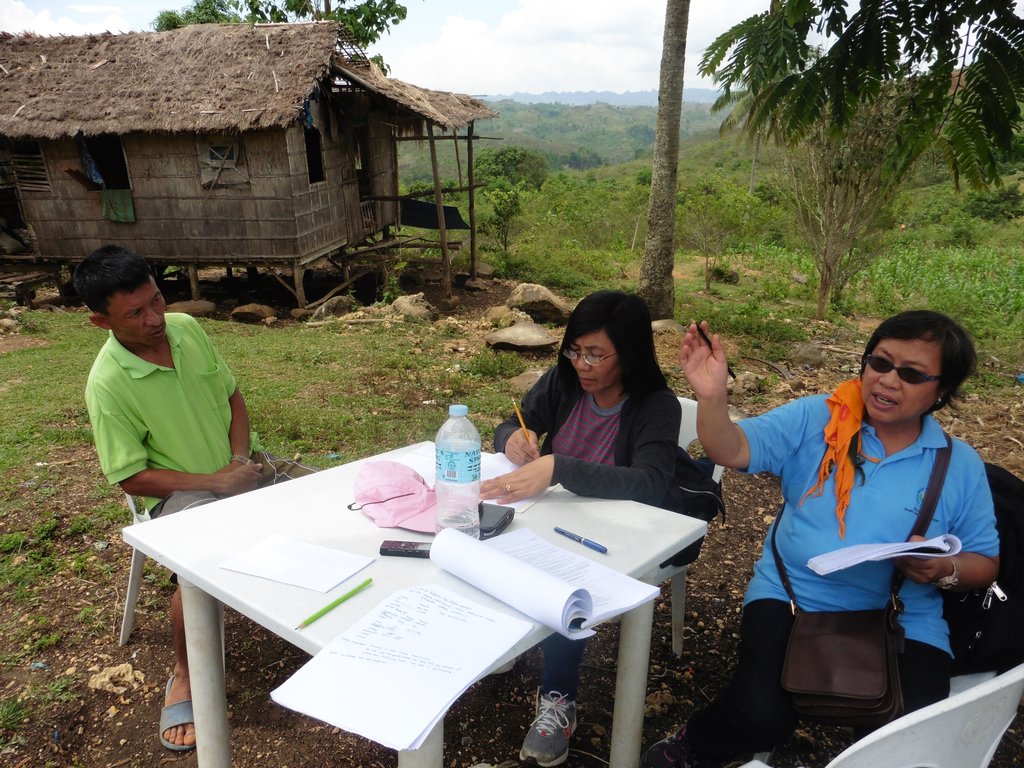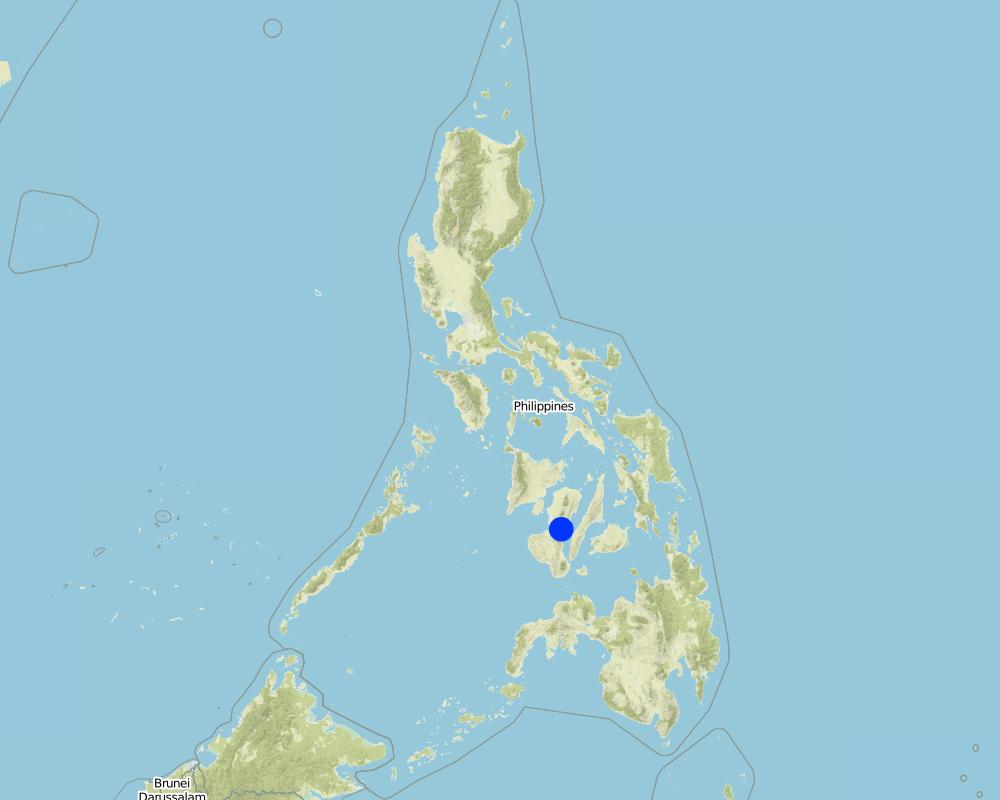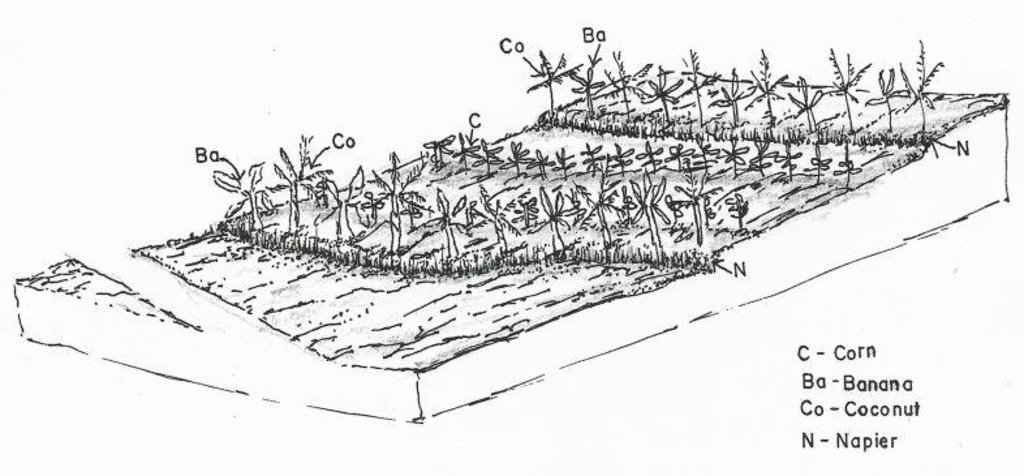Contour Farming using hedgerows [Philippines]
- Creation:
- Update:
- Compiler: Philippine Overview of Conservation Approaches and Technologies
- Editor: –
- Reviewers: Eduardo Alberto, Alexandra Gavilano
Contour Farming
technologies_1287 - Philippines
View sections
Expand all Collapse all1. General information
1.2 Contact details of resource persons and institutions involved in the assessment and documentation of the Technology
Key resource person(s)
SLM specialist:
Luistro Aida
DA_STIARC, RFO IV-A
Philippines
SLM specialist:
Gregorio Elizabeth
DA_STIARC, RFO IV-A
Philippines
SLM specialist:
Dinamling Djolly Ma.
DA-BSWM
Philippines
SLM specialist:
Gutierrez Albert F.
alfergu@yahoo.com
LGU of La Libertad, Negros Oriental
Philippines
Name of the institution(s) which facilitated the documentation/ evaluation of the Technology (if relevant)
LGU of La Libertad - PhilippinesName of the institution(s) which facilitated the documentation/ evaluation of the Technology (if relevant)
Southern Tagalog Integrated Agricultural Research Center (STIARC) - PhilippinesName of the institution(s) which facilitated the documentation/ evaluation of the Technology (if relevant)
Bureau of Soils and Water Management (Bureau of Soils and Water Management) - PhilippinesName of the institution(s) which facilitated the documentation/ evaluation of the Technology (if relevant)
Regional Field Office N0. 4A (RFO IV-A ) - Philippines1.3 Conditions regarding the use of data documented through WOCAT
When were the data compiled (in the field)?
27/05/2015
The compiler and key resource person(s) accept the conditions regarding the use of data documented through WOCAT:
Yes
1.5 Reference to Questionnaire(s) on SLM Approaches
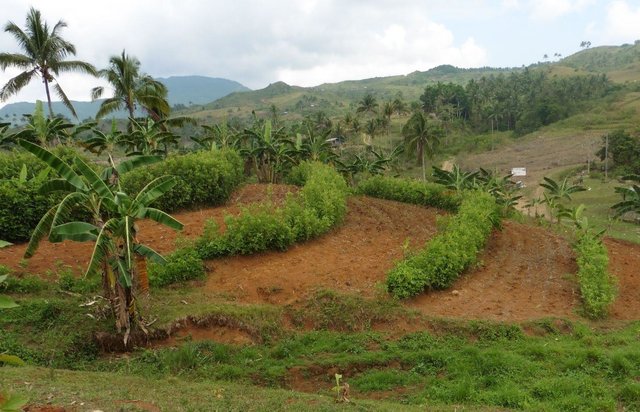
Conservation Farming Village [Philippines]
A modality in mobilizing resources for sustainable upland development which utilizes a basket of strategies, technologies, and interventions to catalyze the widespread transformation of traditional upland farming systems into resilient and sustainable upland production systems.
- Compiler: Philippine Overview of Conservation Approaches and Technologies
2. Description of the SLM Technology
2.1 Short description of the Technology
Definition of the Technology:
Contour farming is a technology practiced in sloping areas in which hedgerows are established along the contours and other annual/cash crops are grown in the alleys between the hedges.
2.2 Detailed description of the Technology
Description:
Contour farming is being practiced by the farmers in sloping areas to prevent or control soil erosion. Hedgerows are established along contour lines using napier grass and permanent crops like banana and coconut. In between contour lines, corn is inter-cropped with peanut. It is a traditional practice of farmers and one of the conservation techniques for the Conservation Farming Village Approach (CFV).
Purpose of the Technology: This is practiced by farmers to control surface run-off, erosion and to conserve natural soil fertility. Napier grass is also planted as source of feeds for the livestocks. The technology controls dispersed runoff, reduce slope angle and length.
Establishment / maintenance activities and inputs: Contour lines were established using an A-frame to determine the location of the hedgerows to be planted. Napier grasses are planted along the contour at 8x8m and 4X4m distance. Grafted cacao trees are also inserted in between banana at 4X4 distance. The alleys between hedges measuring 4m wide and 30m long are planted with corn and peanut. Napier grass is regularly trimmed to maintain a height of not more than a meter, using the cuttings as livestock fodder.
Natural / human environment: The area is under a humid climate condition with an average annual rainfall of 1000-1500 mm. Its elevation is 500-1000 m above mean sea level.The average cropland size of land users is less than or equal to 0. 5 hectare with a slope ranging from 18-25%. Income of land users are derived from the crops sold. The Local Government Unit (LGU) provides truck to transport the harvested crops of the farmers from the village to the town market twice a week.
2.3 Photos of the Technology
2.5 Country/ region/ locations where the Technology has been applied and which are covered by this assessment
Country:
Philippines
Region/ State/ Province:
La Libertad
Further specification of location:
Negros Oriental
Map
×2.6 Date of implementation
If precise year is not known, indicate approximate date:
- more than 50 years ago (traditional)
2.7 Introduction of the Technology
Specify how the Technology was introduced:
- as part of a traditional system (> 50 years)
Comments (type of project, etc.):
The technology is a traditional practice in the Philippines and was integrated as part of the conservation techniques under the Conservation Farming Village approach.
3. Classification of the SLM Technology
3.1 Main purpose(s) of the Technology
- reduce, prevent, restore land degradation
3.2 Current land use type(s) where the Technology is applied

Cropland
- Annual cropping
Main crops (cash and food crops):
major cash crop: peanut
major food crop: corn, banana, cacao, coconut
Other: Napier grasses
Comments:
Major land use problems (compiler’s opinion): Soil erosion and soil fertility decline.
Major land use problems (land users’ perception): Lack of animal grazing areas and limited plain or level areas for crop production.
Livestock is grazing on crop residues
3.3 Further information about land use
Water supply for the land on which the Technology is applied:
- rainfed
3.4 SLM group to which the Technology belongs
- cross-slope measure
3.5 Spread of the Technology
Specify the spread of the Technology:
- evenly spread over an area
If the Technology is evenly spread over an area, indicate approximate area covered:
- < 0.1 km2 (10 ha)
Comments:
Total area covered by the SLM Technology is 0.0025 m2.
Farmers practice contour farming only in small areas or parcels of land
3.6 SLM measures comprising the Technology

agronomic measures
- A1: Vegetation/ soil cover
- A2: Organic matter/ soil fertility
- A3: Soil surface treatment
- A4: Subsurface treatment

vegetative measures
- V1: Tree and shrub cover
- V2: Grasses and perennial herbaceous plants
Comments:
Main measures: agronomic measures, vegetative measures
Type of agronomic measures: mixed cropping / intercropping, contour planting / strip cropping, legume inter-planting, manure / compost / residues, breaking crust / sealed surface
Type of vegetative measures: aligned: -contour
3.7 Main types of land degradation addressed by the Technology

soil erosion by water
- Wt: loss of topsoil/ surface erosion

chemical soil deterioration
- Cn: fertility decline and reduced organic matter content (not caused by erosion)

biological degradation
- Bc: reduction of vegetation cover
Comments:
Main type of degradation addressed: Wt: loss of topsoil / surface erosion, Cn: fertility decline and reduced organic matter content
Secondary types of degradation addressed: Bc: reduction of vegetation cover
Main causes of degradation: soil management (Lack of knowledge on fertilizer usage), crop management (annual, perennial, tree/shrub) (intensive tillage due to crop production), deforestation / removal of natural vegetation (incl. forest fires) (illegal logging, slash and burn), over-exploitation of vegetation for domestic use (charcoal making for livelihood)
3.8 Prevention, reduction, or restoration of land degradation
Specify the goal of the Technology with regard to land degradation:
- restore/ rehabilitate severely degraded land
Comments:
Main goals: rehabilitation / reclamation of denuded land
4. Technical specifications, implementation activities, inputs, and costs
4.1 Technical drawing of the Technology
4.2 Technical specifications/ explanations of technical drawing
Crops planted in the contour.
Location: Brgy. Talaon. La Libertad, Negros Oriental
Date: May28, 2015
Technical knowledge required for field staff / advisors: high
Technical knowledge required for land users: moderate
Main technical functions: control of raindrop splash, control of dispersed runoff: retain / trap, Minimize soil erosion due to runoff, Serve as soil nutrient traps
Secondary technical functions: reduction of slope angle, reduction of slope length, stabilisation of soil (eg by tree roots against land slides), promotion of vegetation species and varieties (quality, eg palatable fodder)
Mixed cropping / intercropping
Material/ species: corn and peanut
Quantity/ density: 10kg/.25ha
Remarks: in between contour hedges
Contour planting / strip cropping
Material/ species: napier, banana, coconut and cacao
Quantity/ density: 20kg/.25ha
Legume inter-planting
Quantity/ density: 20kg/.25ha
Manure / compost / residues
Material/ species: vermi-compost
Quantity/ density: 500kg
Breaking crust / sealed surface
Material/ species: rotavator
Remarks: plowing two times
Aligned: -contour
Vegetative material: G : grass
Number of plants per (ha): 500
Vertical interval between rows / strips / blocks (m): 0.5
Spacing between rows / strips / blocks (m): 4
Vertical interval within rows / strips / blocks (m): drill
Width within rows / strips / blocks (m): 0.3
Vegetative measure: contour (banana)
Vegetative material: F : fruit trees / shrubs
Number of plants per (ha): 64
Vertical interval between rows / strips / blocks (m): 0.5
Spacing between rows / strips / blocks (m): 4
Vertical interval within rows / strips / blocks (m): 4
Width within rows / strips / blocks (m): 4
Vegetative measure: contour (cacao)
Vegetative material: F : fruit trees / shrubs
Number of plants per (ha): 64
Vertical interval between rows / strips / blocks (m): 0.5
Spacing between rows / strips / blocks (m): 4
Vertical interval within rows / strips / blocks (m): 1
Width within rows / strips / blocks (m): 4
Vegetative measure: contour (cococnut)
Vegetative material: F : fruit trees / shrubs
Number of plants per (ha): 32
Vertical interval between rows / strips / blocks (m): 0.5
Spacing between rows / strips / blocks (m): 4
Vertical interval within rows / strips / blocks (m): 8
Width within rows / strips / blocks (m): 8
Vegetative measure: Vegetative material: F : fruit trees / shrubs
Fruit trees / shrubs species: banana, cacao, coconut
Grass species: napier grass
Slope (which determines the spacing indicated above): 8%
If the original slope has changed as a result of the Technology, the slope today is (see figure below): 5%
Gradient along the rows / strips: 3-5%
4.3 General information regarding the calculation of inputs and costs
Specify how costs and inputs were calculated:
- per Technology area
Indicate size and area unit:
1 hectare
Specify currency used for cost calculations:
- US Dollars
Indicate exchange rate from USD to local currency (if relevant): 1 USD =:
49.0
Indicate average wage cost of hired labour per day:
2.22
4.4 Establishment activities
| Activity | Type of measure | Timing | |
|---|---|---|---|
| 1. | Laying out and establishment of contour lines/hedgerows | Vegetative | before onset of rainy season |
| 2. | Planting of hedgerows (Napier grass) | Vegetative | Rainy season. one week after laying out |
| 3. | Planting of perennial crops along contour | Vegetative | Rainy season. 1 week after laying out |
4.5 Costs and inputs needed for establishment
If possible, break down the costs of establishment according to the following table, specifying inputs and costs per input. If you are unable to break down the costs, give an estimation of the total costs of establishing the Technology:
122.77
| Specify input | Unit | Quantity | Costs per Unit | Total costs per input | % of costs borne by land users | |
|---|---|---|---|---|---|---|
| Labour | Laying out and establishment of contour | Person/day | 3.0 | 2.22 | 6.66 | 40.0 |
| Labour | Planting of crops and hedgerows | Person/day | 10.0 | 2.22 | 22.2 | 100.0 |
| Plant material | napier seeds | kg | 300.0 | 0.0133 | 3.99 | 100.0 |
| Plant material | banana seeds | plants | 64.0 | 0.11093 | 7.1 | 100.0 |
| Plant material | cacao seeds | plants | 64.0 | 0.55565 | 35.56 | 100.0 |
| Plant material | coconut seeds | plants | 32.0 | 0.88875 | 28.44 | 100.0 |
| Fertilizers and biocides | herbicide | liter | 1.0 | 17.78 | 17.78 | 40.0 |
| Construction material | bamboosticks | picks | 50.0 | 0.012 | 0.6 | 40.0 |
| Construction material | A-frame | unit | 1.0 | 0.44 | 0.44 | 40.0 |
| Total costs for establishment of the Technology | 122.77 | |||||
4.6 Maintenance/ recurrent activities
| Activity | Type of measure | Timing/ frequency | |
|---|---|---|---|
| 1. | Land clearing/ preparation (plowing, rotavating, harrowing) of alleys between contours | Agronomic | Before onset of rainy season |
| 2. | Furrowing | Agronomic | |
| 3. | Planting of corn (first cropping) | Agronomic | Raining season |
| 4. | Weeding, insect control | Agronomic | |
| 5. | Harvesting of first crop | Agronomic | |
| 6. | Land Preparation for the second cropping (plowing, harrowing/rotavating, furrowing) | Agronomic | |
| 7. | Planting of corn + Planting of peanut (second cropping- corn + peanut) | Agronomic | |
| 8. | Weeding / Insect control | Agronomic | |
| 9. | Harvesting of corn and peanut | Agronomic |
4.7 Costs and inputs needed for maintenance/ recurrent activities (per year)
If possible, break down the costs of maintenance according to the following table, specifying inputs and costs per input. If you are unable to break down the costs, give an estimation of the total costs of maintaining the Technology:
146.63
| Specify input | Unit | Quantity | Costs per Unit | Total costs per input | % of costs borne by land users | |
|---|---|---|---|---|---|---|
| Labour | Land Preparation with machine / furrowing | Person/day | 3.0 | 7.11 | 21.33 | 100.0 |
| Labour | Animal Labour | Person/day | 2.0 | 2.67 | 5.34 | 100.0 |
| Equipment | Other Labour: Weeding, harvesting | Person/day | 14.0 | 2.22 | 31.08 | 100.0 |
| Plant material | Corn seeds | kg | 10.0 | 0.444 | 4.44 | |
| Plant material | Peanut seeds | kg | 20.0 | 2.0 | 40.0 | 100.0 |
| Plant material | Seeds undefined | kg | 10.0 | 0.444 | 4.44 | 100.0 |
| Fertilizers and biocides | Fertilizer | kg | 500.0 | 0.08 | 40.0 | 100.0 |
| Total costs for maintenance of the Technology | 146.63 | |||||
Comments:
Machinery/ tools: rotavator
4.8 Most important factors affecting the costs
Describe the most determinate factors affecting the costs:
The slope of the area contributes to the additional labor cost in the establishment of contours.The steeper the slope, the higher labor cost will be incurred.
5. Natural and human environment
5.1 Climate
Annual rainfall
- < 250 mm
- 251-500 mm
- 501-750 mm
- 751-1,000 mm
- 1,001-1,500 mm
- 1,501-2,000 mm
- 2,001-3,000 mm
- 3,001-4,000 mm
- > 4,000 mm
Agro-climatic zone
- humid
Thermal climate class: tropics
5.2 Topography
Slopes on average:
- flat (0-2%)
- gentle (3-5%)
- moderate (6-10%)
- rolling (11-15%)
- hilly (16-30%)
- steep (31-60%)
- very steep (>60%)
Landforms:
- plateau/plains
- ridges
- mountain slopes
- hill slopes
- footslopes
- valley floors
Altitudinal zone:
- 0-100 m a.s.l.
- 101-500 m a.s.l.
- 501-1,000 m a.s.l.
- 1,001-1,500 m a.s.l.
- 1,501-2,000 m a.s.l.
- 2,001-2,500 m a.s.l.
- 2,501-3,000 m a.s.l.
- 3,001-4,000 m a.s.l.
- > 4,000 m a.s.l.
Indicate if the Technology is specifically applied in:
- not relevant
Comments and further specifications on topography:
Altitudinal zones: 720 m
5.3 Soils
Soil depth on average:
- very shallow (0-20 cm)
- shallow (21-50 cm)
- moderately deep (51-80 cm)
- deep (81-120 cm)
- very deep (> 120 cm)
Soil texture (topsoil):
- medium (loamy, silty)
Topsoil organic matter:
- medium (1-3%)
5.4 Water availability and quality
Ground water table:
5-50 m
Availability of surface water:
good
Water quality (untreated):
good drinking water
5.5 Biodiversity
Species diversity:
- low
5.6 Characteristics of land users applying the Technology
Market orientation of production system:
- mixed (subsistence/ commercial
Off-farm income:
- less than 10% of all income
Relative level of wealth:
- poor
Individuals or groups:
- individual/ household
Level of mechanization:
- manual work
- animal traction
Gender:
- women
- men
Indicate other relevant characteristics of the land users:
Land users applying the Technology are mainly disadvantaged land users
Population density: 10-50 persons/km2
Annual population growth: 1% - 2%; 2%
70% of the land users are poor and own 70% of the land.
Off-farm income specification: Hired laborers for the Department of Environment and Natural Resources (DENR) Project on National Greening Program
5.7 Average area of land owned or leased by land users applying the Technology
- < 0.5 ha
- 0.5-1 ha
- 1-2 ha
- 2-5 ha
- 5-15 ha
- 15-50 ha
- 50-100 ha
- 100-500 ha
- 500-1,000 ha
- 1,000-10,000 ha
- > 10,000 ha
Is this considered small-, medium- or large-scale (referring to local context)?
- small-scale
5.8 Land ownership, land use rights, and water use rights
Land ownership:
- individual, not titled
Land use rights:
- individual
Water use rights:
- communal (organized)
5.9 Access to services and infrastructure
health:
- poor
- moderate
- good
education:
- poor
- moderate
- good
technical assistance:
- poor
- moderate
- good
employment (e.g. off-farm):
- poor
- moderate
- good
markets:
- poor
- moderate
- good
energy:
- poor
- moderate
- good
roads and transport:
- poor
- moderate
- good
drinking water and sanitation:
- poor
- moderate
- good
financial services:
- poor
- moderate
- good
6. Impacts and concluding statements
6.1 On-site impacts the Technology has shown
Socio-economic impacts
Production
crop production
Quantity before SLM:
0
Quantity after SLM:
10 bags
fodder production
Quantity before SLM:
0
Quantity after SLM:
1350 bundles
fodder quality
product diversity
land management
Income and costs
farm income
diversity of income sources
workload
Socio-cultural impacts
recreational opportunities
community institutions
national institutions
conflict mitigation
situation of socially and economically disadvantaged groups
Improved livelihood and human well-being
Ecological impacts
Soil
soil cover
soil loss
nutrient cycling/ recharge
soil organic matter/ below ground C
Biodiversity: vegetation, animals
biomass/ above ground C
plant diversity
habitat diversity
Climate and disaster risk reduction
emission of carbon and greenhouse gases
wind velocity
6.3 Exposure and sensitivity of the Technology to gradual climate change and climate-related extremes/ disasters (as perceived by land users)
Gradual climate change
Gradual climate change
| Season | Type of climatic change/ extreme | How does the Technology cope with it? | |
|---|---|---|---|
| annual temperature | increase | not well |
Climate-related extremes (disasters)
Meteorological disasters
| How does the Technology cope with it? | |
|---|---|
| local rainstorm | not well |
Climatological disasters
| How does the Technology cope with it? | |
|---|---|
| drought | not well |
Hydrological disasters
| How does the Technology cope with it? | |
|---|---|
| general (river) flood | not well |
6.4 Cost-benefit analysis
How do the benefits compare with the establishment costs (from land users’ perspective)?
Short-term returns:
very positive
Long-term returns:
very positive
How do the benefits compare with the maintenance/ recurrent costs (from land users' perspective)?
Short-term returns:
very positive
Long-term returns:
very positive
Comments:
More income added from Napier grass
6.5 Adoption of the Technology
If available, quantify (no. of households and/ or area covered):
18 land user families have adopted the Technology
Of all those who have adopted the Technology, how many have did so spontaneously, i.e. without receiving any material incentives/ payments?
- 10-50%
Comments:
Comments on acceptance with external material support: Single farmer focused on napier production and used as hedgerows
28% of land user families (4) who have adopted the Technology did it spontaneously.
4 land user families have adopted the Technology without any external material support
Comments on spontaneous adoption: Practiced contouring but some are partial adoption (rock wall)
There is a strong trend towards spontaneous adoption of the Technology
Comments on adoption trend: Additional barangays will be adopting the technology.
6.7 Strengths/ advantages/ opportunities of the Technology
| Strengths/ advantages/ opportunities in the land user’s view |
|---|
|
Availability of labor force in the community. How can they be sustained / enhanced? Encourage more farmers to adopt the technology and utilize available labor force. |
|
The technology generated jobs and increase the income of the landusers practicing the technology. How can they be sustained / enhanced? To conduct continuous capacity building to land users and their children to ensure sustainability. |
| Strengths/ advantages/ opportunities in the compiler’s or other key resource person’s view |
|---|
|
Soil erosion was reduced because of the presence of the hedge rows that traps eroded soil. How can they be sustained / enhanced? Include other structural measures such as silt traps and brush dams to trap silts. |
|
The kind of hedgerows planted depends on the need of the landusers. Farmers with livestock used napier and forage grasses as hedges while others planted perennial and cash crop to supplement their food requirement. How can they be sustained / enhanced? Conduct crop suitability evaluation and market study. |
6.8 Weaknesses/ disadvantages/ risks of the Technology and ways of overcoming them
| Weaknesses/ disadvantages/ risks in the land user’s view | How can they be overcome? |
|---|---|
| Poor road network from the center of the town to the barangay. | Construction of farm-to-market road to improve the accessibility of the barangay. |
| Weaknesses/ disadvantages/ risks in the compiler’s or other key resource person’s view | How can they be overcome? |
|---|---|
| Lack of irrigation system in the cropping area | Provision of irrigation system such as solar pump and small farm reservoir. |
7. References and links
7.1 Methods/ sources of information
- field visits, field surveys
- interviews with land users
Links and modules
Expand all Collapse allLinks

Conservation Farming Village [Philippines]
A modality in mobilizing resources for sustainable upland development which utilizes a basket of strategies, technologies, and interventions to catalyze the widespread transformation of traditional upland farming systems into resilient and sustainable upland production systems.
- Compiler: Philippine Overview of Conservation Approaches and Technologies
Modules
No modules


